Comprehensive Design Document: Hilton Hotel Reservation System Project
VerifiedAdded on 2022/12/29
|14
|2619
|1
Project
AI Summary
This document presents the architectural design of a proposed Hilton Hotel Reservation System. It begins with an introduction highlighting the need for such a system in the hospitality industry, particularly to cater to tech-savvy millennial customers. The design goals emphasize system stability, ease of use, and data security. The document outlines the system's behavior from a customer's perspective, including the booking process and interaction flow. It then delves into the logical view, detailing the system's components, including client and administrative interfaces, business logic, data storage, and an analytics engine. The design is further elaborated through high-level, mid-level, and detailed class diagrams, showcasing the static and dynamic aspects of the system. Process and physical views, including the technology stack (Python, Django, Oracle RDBMS, and cloud deployment), are also described. The document concludes with a use case view, solidifying the design of a comprehensive online reservation system for the Hilton Group of Hotels.
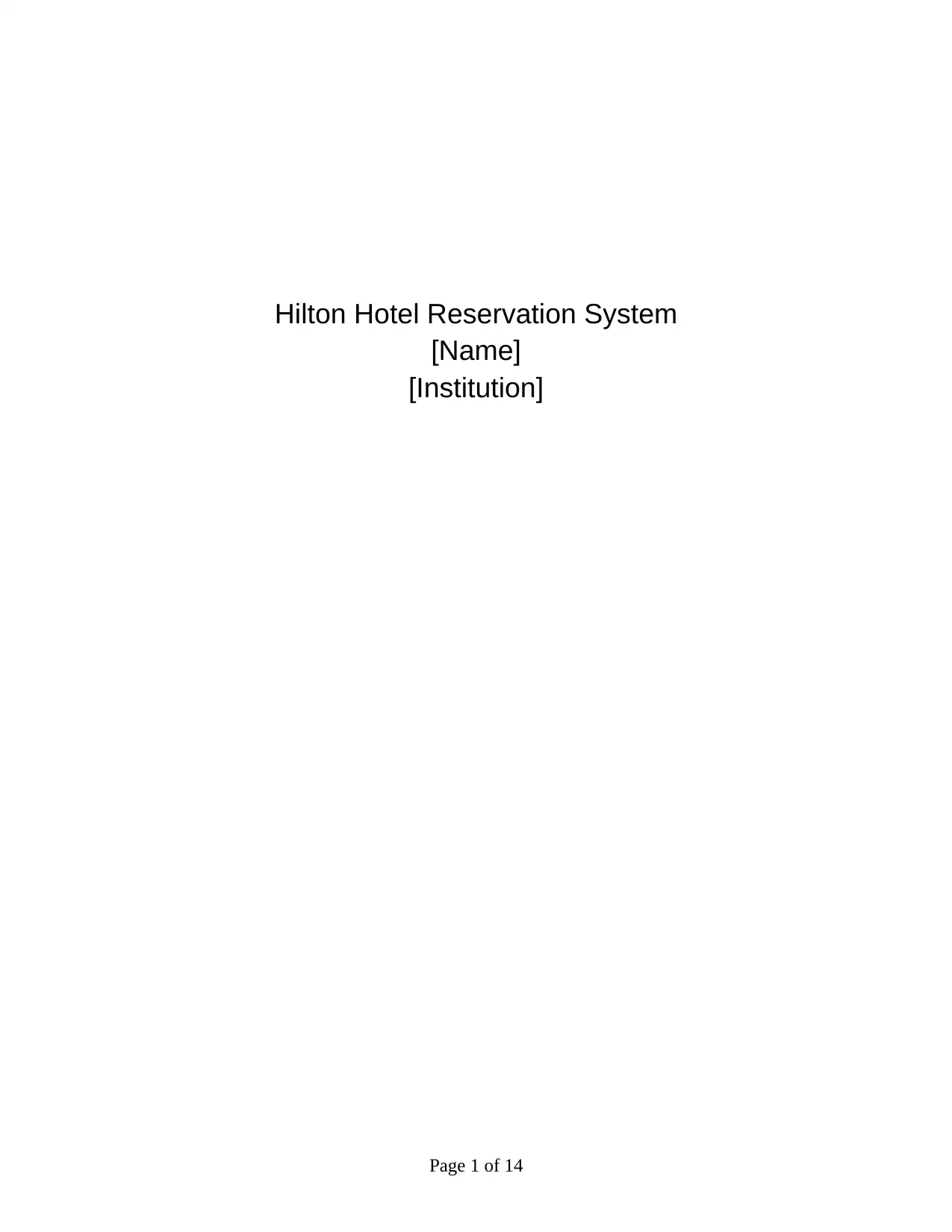
Hilton Hotel Reservation System
[Name]
[Institution]
Page 1 of 14
[Name]
[Institution]
Page 1 of 14
Paraphrase This Document
Need a fresh take? Get an instant paraphrase of this document with our AI Paraphraser
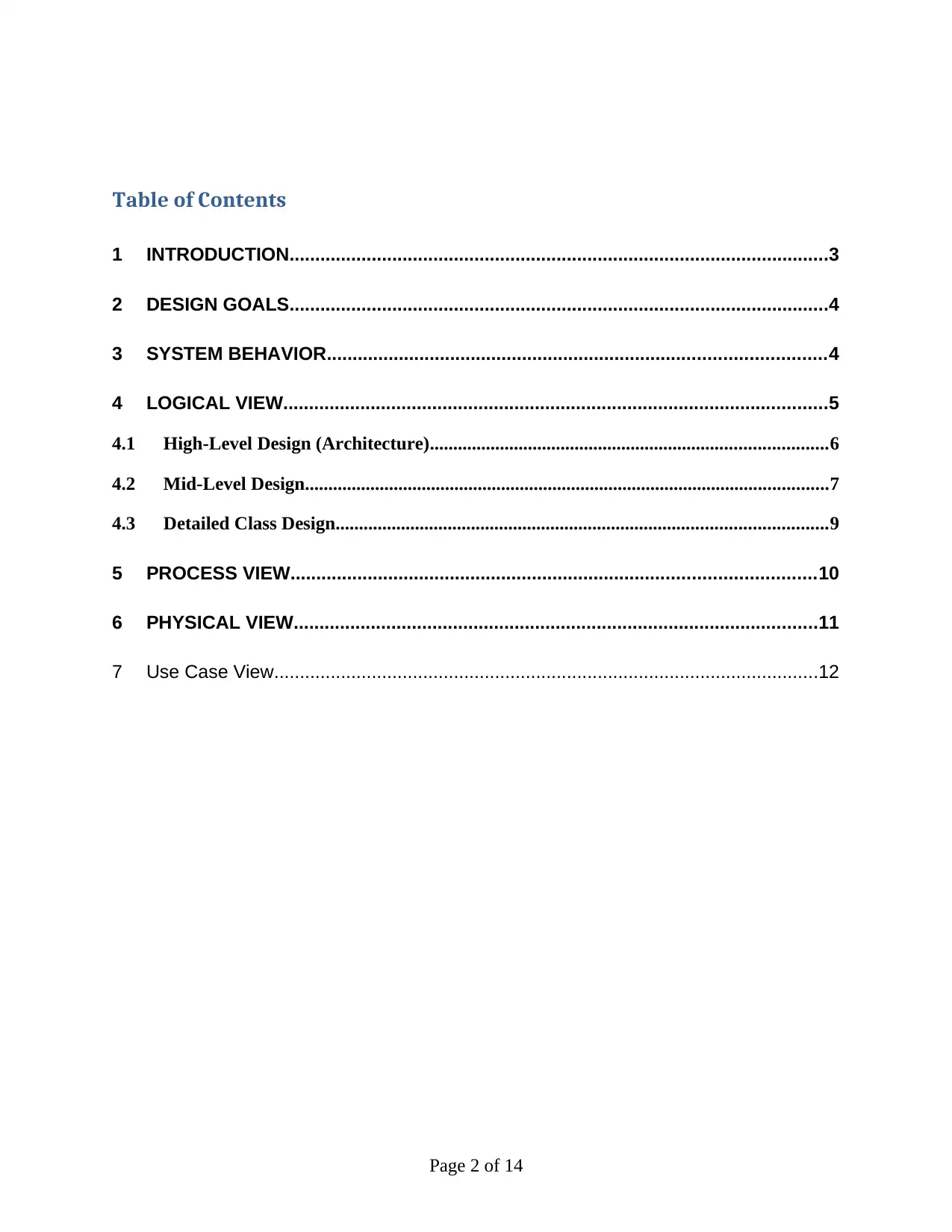
Table of Contents
1 INTRODUCTION.........................................................................................................3
2 DESIGN GOALS.........................................................................................................4
3 SYSTEM BEHAVIOR.................................................................................................4
4 LOGICAL VIEW..........................................................................................................5
4.1 High-Level Design (Architecture).....................................................................................6
4.2 Mid-Level Design................................................................................................................7
4.3 Detailed Class Design.........................................................................................................9
5 PROCESS VIEW......................................................................................................10
6 PHYSICAL VIEW......................................................................................................11
7 Use Case View..........................................................................................................12
Page 2 of 14
1 INTRODUCTION.........................................................................................................3
2 DESIGN GOALS.........................................................................................................4
3 SYSTEM BEHAVIOR.................................................................................................4
4 LOGICAL VIEW..........................................................................................................5
4.1 High-Level Design (Architecture).....................................................................................6
4.2 Mid-Level Design................................................................................................................7
4.3 Detailed Class Design.........................................................................................................9
5 PROCESS VIEW......................................................................................................10
6 PHYSICAL VIEW......................................................................................................11
7 Use Case View..........................................................................................................12
Page 2 of 14
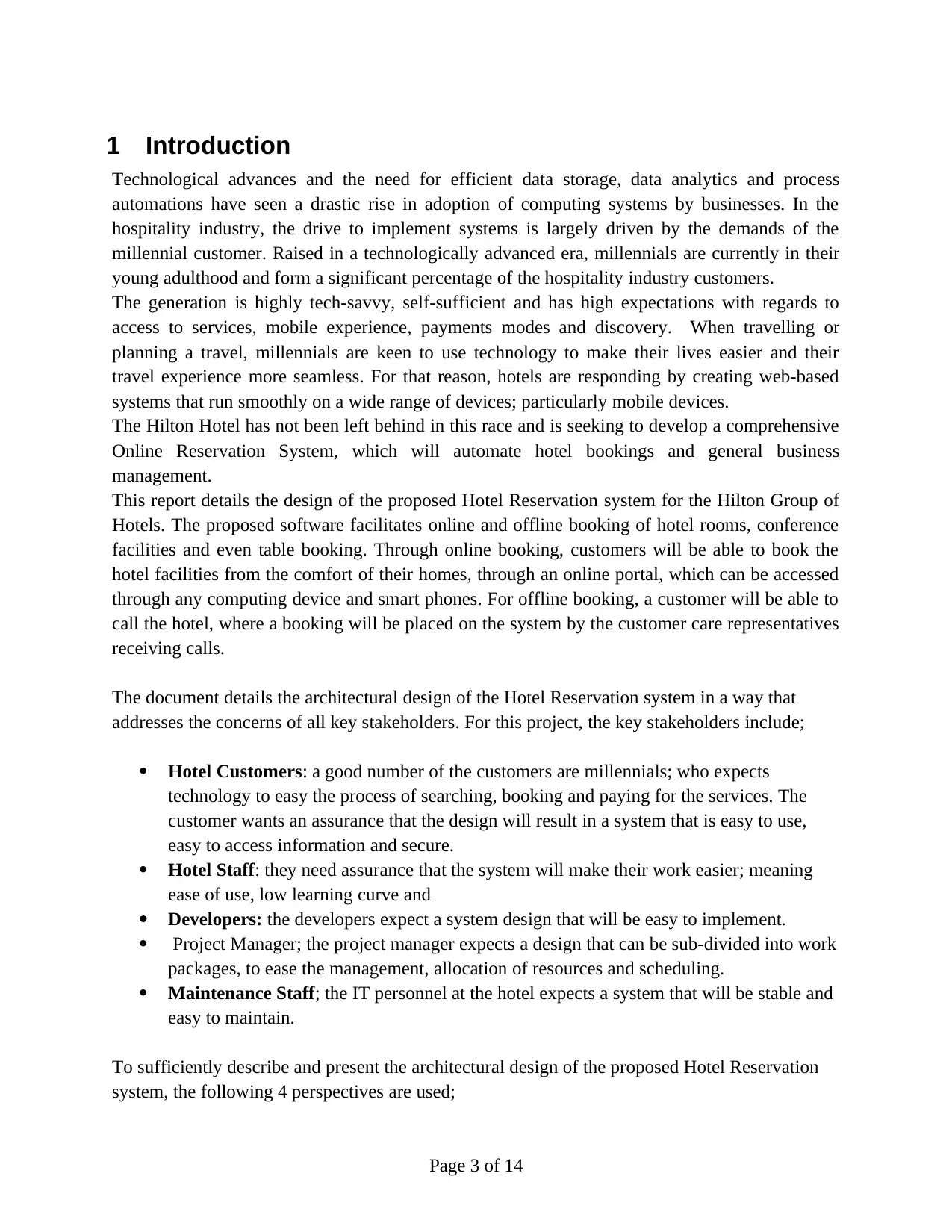
1 Introduction
Technological advances and the need for efficient data storage, data analytics and process
automations have seen a drastic rise in adoption of computing systems by businesses. In the
hospitality industry, the drive to implement systems is largely driven by the demands of the
millennial customer. Raised in a technologically advanced era, millennials are currently in their
young adulthood and form a significant percentage of the hospitality industry customers.
The generation is highly tech-savvy, self-sufficient and has high expectations with regards to
access to services, mobile experience, payments modes and discovery. When travelling or
planning a travel, millennials are keen to use technology to make their lives easier and their
travel experience more seamless. For that reason, hotels are responding by creating web-based
systems that run smoothly on a wide range of devices; particularly mobile devices.
The Hilton Hotel has not been left behind in this race and is seeking to develop a comprehensive
Online Reservation System, which will automate hotel bookings and general business
management.
This report details the design of the proposed Hotel Reservation system for the Hilton Group of
Hotels. The proposed software facilitates online and offline booking of hotel rooms, conference
facilities and even table booking. Through online booking, customers will be able to book the
hotel facilities from the comfort of their homes, through an online portal, which can be accessed
through any computing device and smart phones. For offline booking, a customer will be able to
call the hotel, where a booking will be placed on the system by the customer care representatives
receiving calls.
The document details the architectural design of the Hotel Reservation system in a way that
addresses the concerns of all key stakeholders. For this project, the key stakeholders include;
Hotel Customers: a good number of the customers are millennials; who expects
technology to easy the process of searching, booking and paying for the services. The
customer wants an assurance that the design will result in a system that is easy to use,
easy to access information and secure.
Hotel Staff: they need assurance that the system will make their work easier; meaning
ease of use, low learning curve and
Developers: the developers expect a system design that will be easy to implement.
Project Manager; the project manager expects a design that can be sub-divided into work
packages, to ease the management, allocation of resources and scheduling.
Maintenance Staff; the IT personnel at the hotel expects a system that will be stable and
easy to maintain.
To sufficiently describe and present the architectural design of the proposed Hotel Reservation
system, the following 4 perspectives are used;
Page 3 of 14
Technological advances and the need for efficient data storage, data analytics and process
automations have seen a drastic rise in adoption of computing systems by businesses. In the
hospitality industry, the drive to implement systems is largely driven by the demands of the
millennial customer. Raised in a technologically advanced era, millennials are currently in their
young adulthood and form a significant percentage of the hospitality industry customers.
The generation is highly tech-savvy, self-sufficient and has high expectations with regards to
access to services, mobile experience, payments modes and discovery. When travelling or
planning a travel, millennials are keen to use technology to make their lives easier and their
travel experience more seamless. For that reason, hotels are responding by creating web-based
systems that run smoothly on a wide range of devices; particularly mobile devices.
The Hilton Hotel has not been left behind in this race and is seeking to develop a comprehensive
Online Reservation System, which will automate hotel bookings and general business
management.
This report details the design of the proposed Hotel Reservation system for the Hilton Group of
Hotels. The proposed software facilitates online and offline booking of hotel rooms, conference
facilities and even table booking. Through online booking, customers will be able to book the
hotel facilities from the comfort of their homes, through an online portal, which can be accessed
through any computing device and smart phones. For offline booking, a customer will be able to
call the hotel, where a booking will be placed on the system by the customer care representatives
receiving calls.
The document details the architectural design of the Hotel Reservation system in a way that
addresses the concerns of all key stakeholders. For this project, the key stakeholders include;
Hotel Customers: a good number of the customers are millennials; who expects
technology to easy the process of searching, booking and paying for the services. The
customer wants an assurance that the design will result in a system that is easy to use,
easy to access information and secure.
Hotel Staff: they need assurance that the system will make their work easier; meaning
ease of use, low learning curve and
Developers: the developers expect a system design that will be easy to implement.
Project Manager; the project manager expects a design that can be sub-divided into work
packages, to ease the management, allocation of resources and scheduling.
Maintenance Staff; the IT personnel at the hotel expects a system that will be stable and
easy to maintain.
To sufficiently describe and present the architectural design of the proposed Hotel Reservation
system, the following 4 perspectives are used;
Page 3 of 14
⊘ This is a preview!⊘
Do you want full access?
Subscribe today to unlock all pages.

Trusted by 1+ million students worldwide
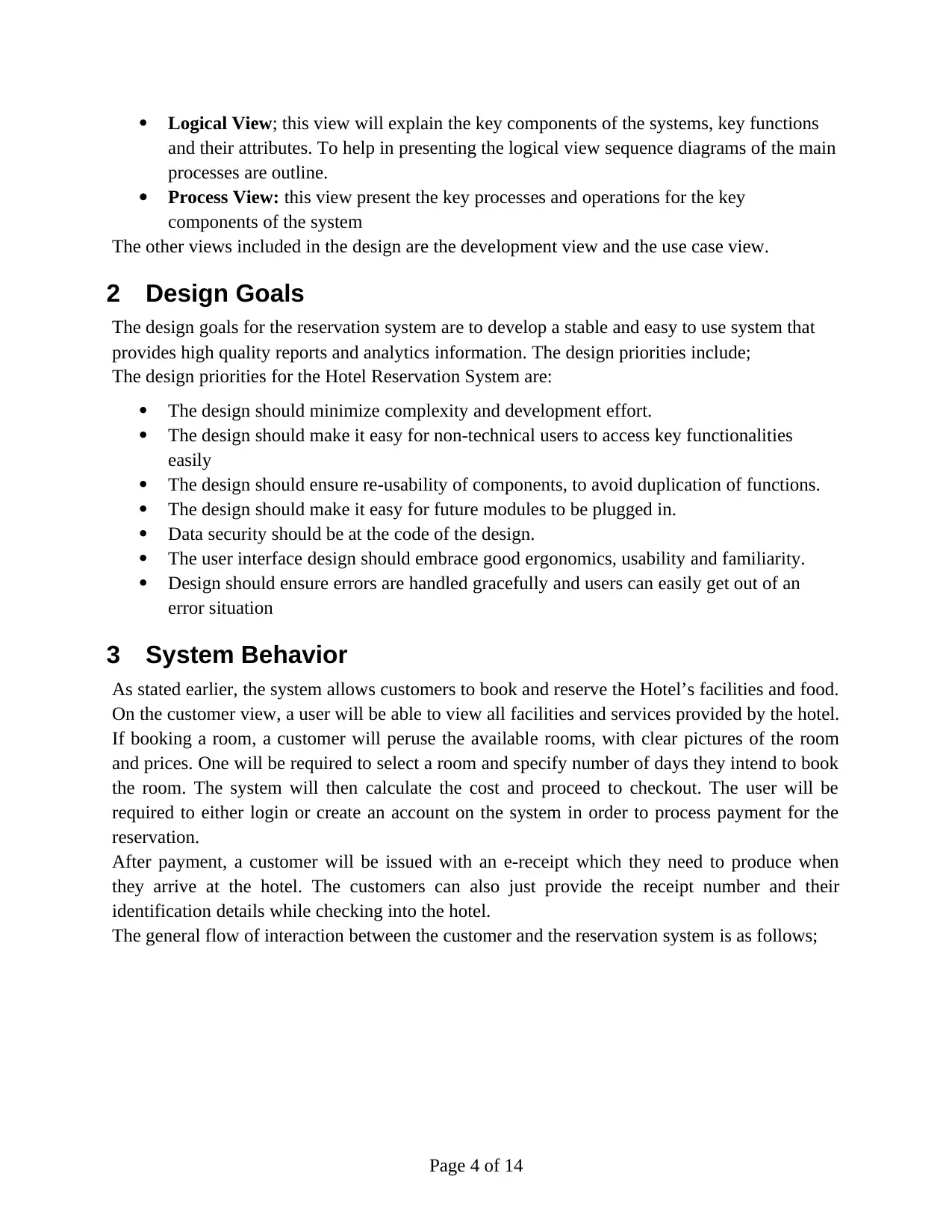
Logical View; this view will explain the key components of the systems, key functions
and their attributes. To help in presenting the logical view sequence diagrams of the main
processes are outline.
Process View: this view present the key processes and operations for the key
components of the system
The other views included in the design are the development view and the use case view.
2 Design Goals
The design goals for the reservation system are to develop a stable and easy to use system that
provides high quality reports and analytics information. The design priorities include;
The design priorities for the Hotel Reservation System are:
The design should minimize complexity and development effort.
The design should make it easy for non-technical users to access key functionalities
easily
The design should ensure re-usability of components, to avoid duplication of functions.
The design should make it easy for future modules to be plugged in.
Data security should be at the code of the design.
The user interface design should embrace good ergonomics, usability and familiarity.
Design should ensure errors are handled gracefully and users can easily get out of an
error situation
3 System Behavior
As stated earlier, the system allows customers to book and reserve the Hotel’s facilities and food.
On the customer view, a user will be able to view all facilities and services provided by the hotel.
If booking a room, a customer will peruse the available rooms, with clear pictures of the room
and prices. One will be required to select a room and specify number of days they intend to book
the room. The system will then calculate the cost and proceed to checkout. The user will be
required to either login or create an account on the system in order to process payment for the
reservation.
After payment, a customer will be issued with an e-receipt which they need to produce when
they arrive at the hotel. The customers can also just provide the receipt number and their
identification details while checking into the hotel.
The general flow of interaction between the customer and the reservation system is as follows;
Page 4 of 14
and their attributes. To help in presenting the logical view sequence diagrams of the main
processes are outline.
Process View: this view present the key processes and operations for the key
components of the system
The other views included in the design are the development view and the use case view.
2 Design Goals
The design goals for the reservation system are to develop a stable and easy to use system that
provides high quality reports and analytics information. The design priorities include;
The design priorities for the Hotel Reservation System are:
The design should minimize complexity and development effort.
The design should make it easy for non-technical users to access key functionalities
easily
The design should ensure re-usability of components, to avoid duplication of functions.
The design should make it easy for future modules to be plugged in.
Data security should be at the code of the design.
The user interface design should embrace good ergonomics, usability and familiarity.
Design should ensure errors are handled gracefully and users can easily get out of an
error situation
3 System Behavior
As stated earlier, the system allows customers to book and reserve the Hotel’s facilities and food.
On the customer view, a user will be able to view all facilities and services provided by the hotel.
If booking a room, a customer will peruse the available rooms, with clear pictures of the room
and prices. One will be required to select a room and specify number of days they intend to book
the room. The system will then calculate the cost and proceed to checkout. The user will be
required to either login or create an account on the system in order to process payment for the
reservation.
After payment, a customer will be issued with an e-receipt which they need to produce when
they arrive at the hotel. The customers can also just provide the receipt number and their
identification details while checking into the hotel.
The general flow of interaction between the customer and the reservation system is as follows;
Page 4 of 14
Paraphrase This Document
Need a fresh take? Get an instant paraphrase of this document with our AI Paraphraser
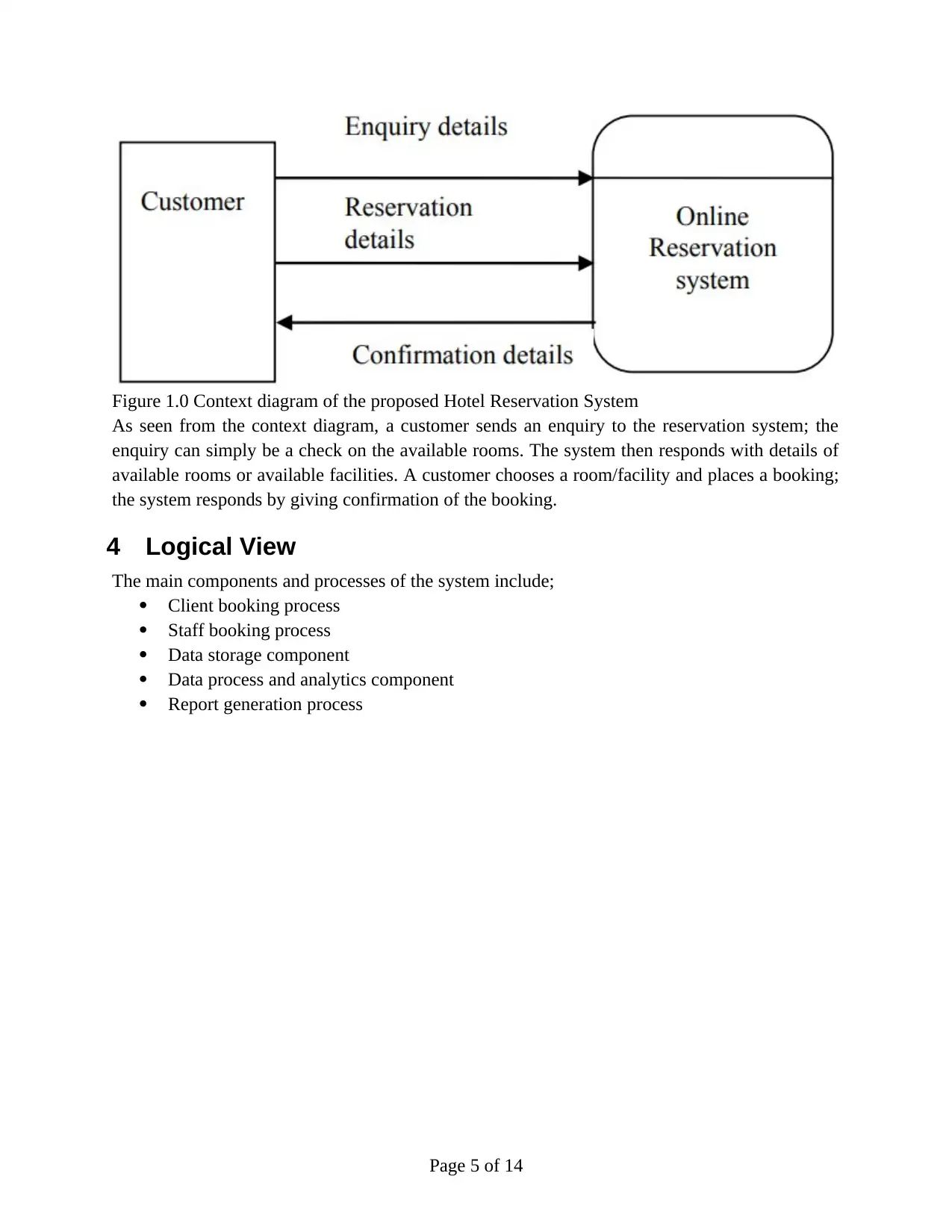
Figure 1.0 Context diagram of the proposed Hotel Reservation System
As seen from the context diagram, a customer sends an enquiry to the reservation system; the
enquiry can simply be a check on the available rooms. The system then responds with details of
available rooms or available facilities. A customer chooses a room/facility and places a booking;
the system responds by giving confirmation of the booking.
4 Logical View
The main components and processes of the system include;
Client booking process
Staff booking process
Data storage component
Data process and analytics component
Report generation process
Page 5 of 14
As seen from the context diagram, a customer sends an enquiry to the reservation system; the
enquiry can simply be a check on the available rooms. The system then responds with details of
available rooms or available facilities. A customer chooses a room/facility and places a booking;
the system responds by giving confirmation of the booking.
4 Logical View
The main components and processes of the system include;
Client booking process
Staff booking process
Data storage component
Data process and analytics component
Report generation process
Page 5 of 14
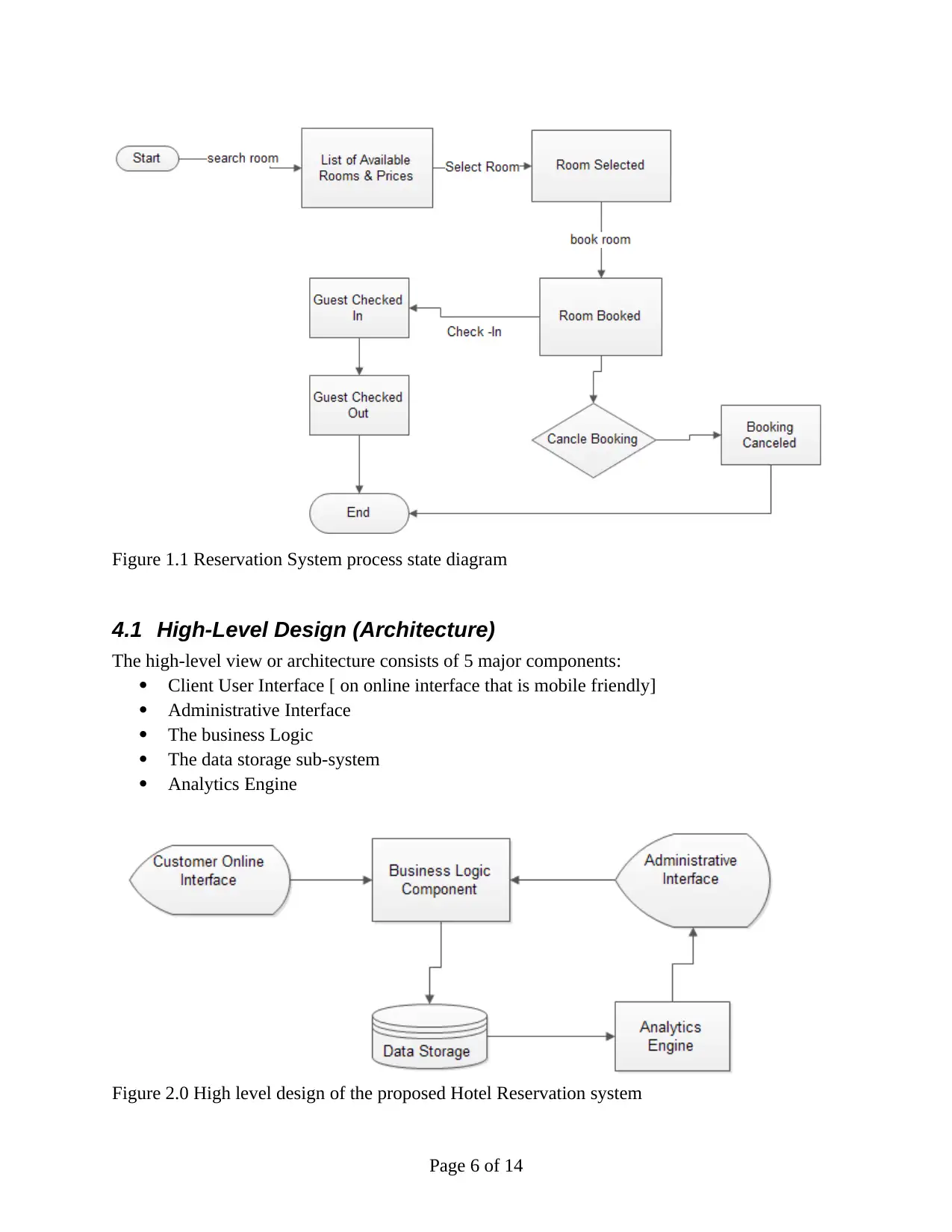
Figure 1.1 Reservation System process state diagram
4.1 High-Level Design (Architecture)
The high-level view or architecture consists of 5 major components:
Client User Interface [ on online interface that is mobile friendly]
Administrative Interface
The business Logic
The data storage sub-system
Analytics Engine
Figure 2.0 High level design of the proposed Hotel Reservation system
Page 6 of 14
4.1 High-Level Design (Architecture)
The high-level view or architecture consists of 5 major components:
Client User Interface [ on online interface that is mobile friendly]
Administrative Interface
The business Logic
The data storage sub-system
Analytics Engine
Figure 2.0 High level design of the proposed Hotel Reservation system
Page 6 of 14
⊘ This is a preview!⊘
Do you want full access?
Subscribe today to unlock all pages.

Trusted by 1+ million students worldwide
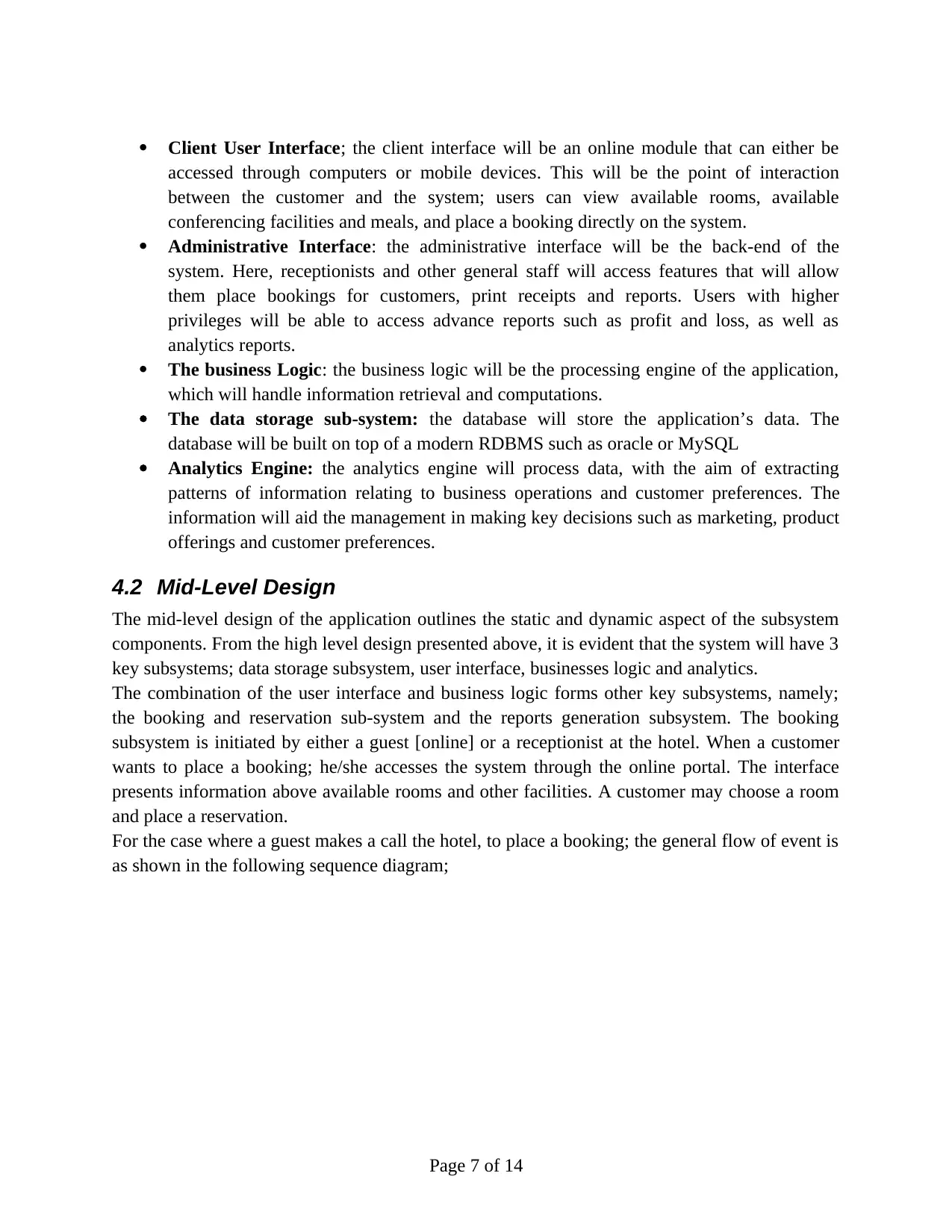
Client User Interface; the client interface will be an online module that can either be
accessed through computers or mobile devices. This will be the point of interaction
between the customer and the system; users can view available rooms, available
conferencing facilities and meals, and place a booking directly on the system.
Administrative Interface: the administrative interface will be the back-end of the
system. Here, receptionists and other general staff will access features that will allow
them place bookings for customers, print receipts and reports. Users with higher
privileges will be able to access advance reports such as profit and loss, as well as
analytics reports.
The business Logic: the business logic will be the processing engine of the application,
which will handle information retrieval and computations.
The data storage sub-system: the database will store the application’s data. The
database will be built on top of a modern RDBMS such as oracle or MySQL
Analytics Engine: the analytics engine will process data, with the aim of extracting
patterns of information relating to business operations and customer preferences. The
information will aid the management in making key decisions such as marketing, product
offerings and customer preferences.
4.2 Mid-Level Design
The mid-level design of the application outlines the static and dynamic aspect of the subsystem
components. From the high level design presented above, it is evident that the system will have 3
key subsystems; data storage subsystem, user interface, businesses logic and analytics.
The combination of the user interface and business logic forms other key subsystems, namely;
the booking and reservation sub-system and the reports generation subsystem. The booking
subsystem is initiated by either a guest [online] or a receptionist at the hotel. When a customer
wants to place a booking; he/she accesses the system through the online portal. The interface
presents information above available rooms and other facilities. A customer may choose a room
and place a reservation.
For the case where a guest makes a call the hotel, to place a booking; the general flow of event is
as shown in the following sequence diagram;
Page 7 of 14
accessed through computers or mobile devices. This will be the point of interaction
between the customer and the system; users can view available rooms, available
conferencing facilities and meals, and place a booking directly on the system.
Administrative Interface: the administrative interface will be the back-end of the
system. Here, receptionists and other general staff will access features that will allow
them place bookings for customers, print receipts and reports. Users with higher
privileges will be able to access advance reports such as profit and loss, as well as
analytics reports.
The business Logic: the business logic will be the processing engine of the application,
which will handle information retrieval and computations.
The data storage sub-system: the database will store the application’s data. The
database will be built on top of a modern RDBMS such as oracle or MySQL
Analytics Engine: the analytics engine will process data, with the aim of extracting
patterns of information relating to business operations and customer preferences. The
information will aid the management in making key decisions such as marketing, product
offerings and customer preferences.
4.2 Mid-Level Design
The mid-level design of the application outlines the static and dynamic aspect of the subsystem
components. From the high level design presented above, it is evident that the system will have 3
key subsystems; data storage subsystem, user interface, businesses logic and analytics.
The combination of the user interface and business logic forms other key subsystems, namely;
the booking and reservation sub-system and the reports generation subsystem. The booking
subsystem is initiated by either a guest [online] or a receptionist at the hotel. When a customer
wants to place a booking; he/she accesses the system through the online portal. The interface
presents information above available rooms and other facilities. A customer may choose a room
and place a reservation.
For the case where a guest makes a call the hotel, to place a booking; the general flow of event is
as shown in the following sequence diagram;
Page 7 of 14
Paraphrase This Document
Need a fresh take? Get an instant paraphrase of this document with our AI Paraphraser
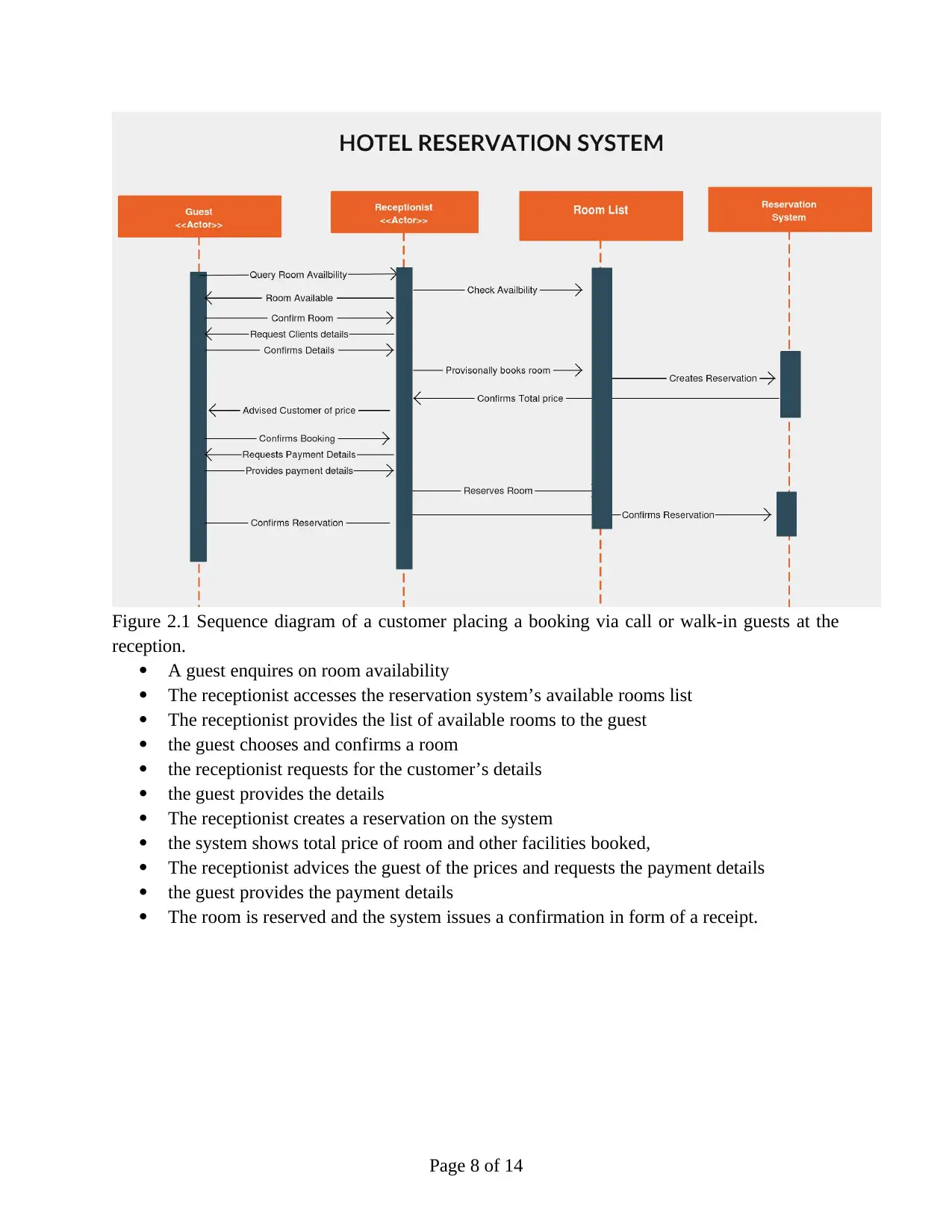
Figure 2.1 Sequence diagram of a customer placing a booking via call or walk-in guests at the
reception.
A guest enquires on room availability
The receptionist accesses the reservation system’s available rooms list
The receptionist provides the list of available rooms to the guest
the guest chooses and confirms a room
the receptionist requests for the customer’s details
the guest provides the details
The receptionist creates a reservation on the system
the system shows total price of room and other facilities booked,
The receptionist advices the guest of the prices and requests the payment details
the guest provides the payment details
The room is reserved and the system issues a confirmation in form of a receipt.
Page 8 of 14
reception.
A guest enquires on room availability
The receptionist accesses the reservation system’s available rooms list
The receptionist provides the list of available rooms to the guest
the guest chooses and confirms a room
the receptionist requests for the customer’s details
the guest provides the details
The receptionist creates a reservation on the system
the system shows total price of room and other facilities booked,
The receptionist advices the guest of the prices and requests the payment details
the guest provides the payment details
The room is reserved and the system issues a confirmation in form of a receipt.
Page 8 of 14
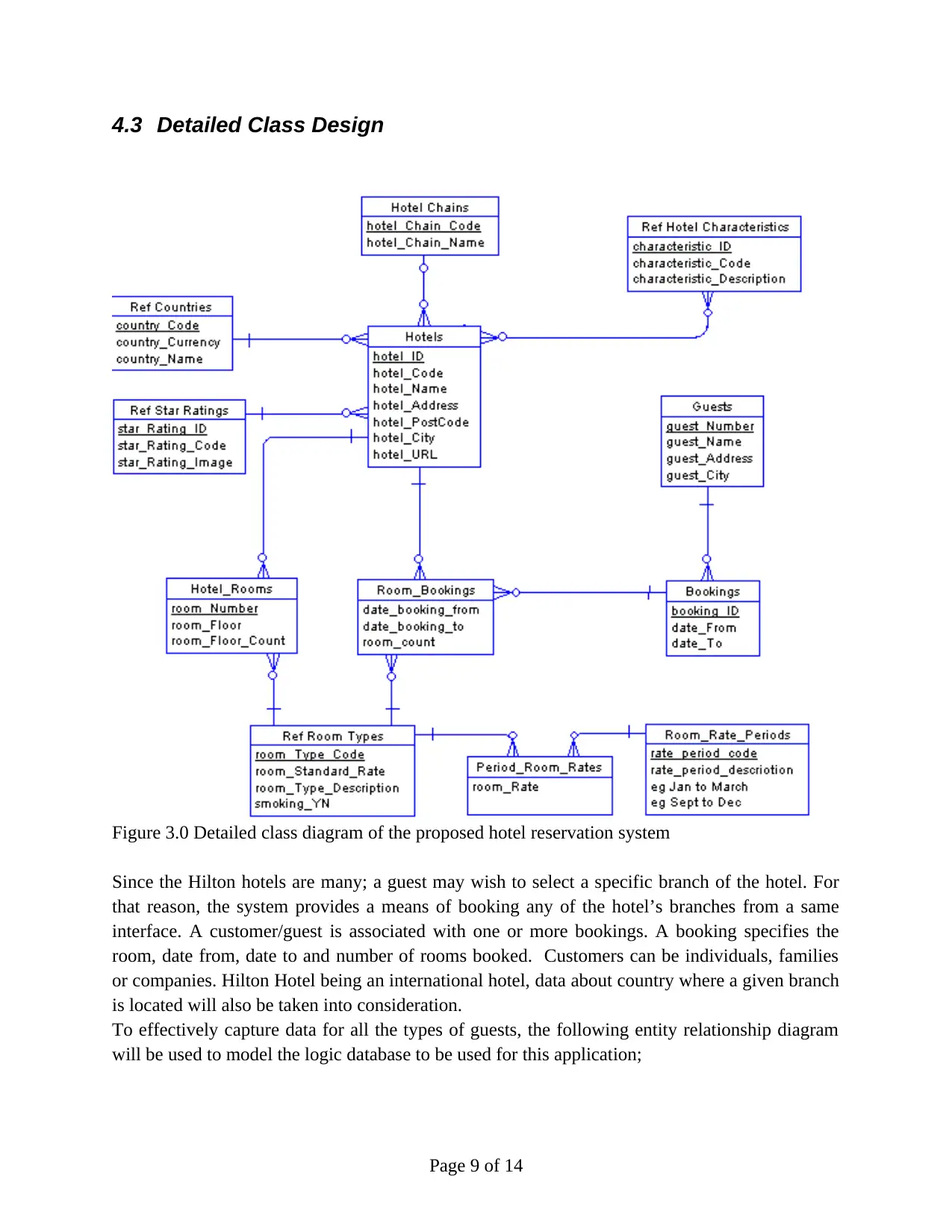
4.3 Detailed Class Design
Figure 3.0 Detailed class diagram of the proposed hotel reservation system
Since the Hilton hotels are many; a guest may wish to select a specific branch of the hotel. For
that reason, the system provides a means of booking any of the hotel’s branches from a same
interface. A customer/guest is associated with one or more bookings. A booking specifies the
room, date from, date to and number of rooms booked. Customers can be individuals, families
or companies. Hilton Hotel being an international hotel, data about country where a given branch
is located will also be taken into consideration.
To effectively capture data for all the types of guests, the following entity relationship diagram
will be used to model the logic database to be used for this application;
Page 9 of 14
Figure 3.0 Detailed class diagram of the proposed hotel reservation system
Since the Hilton hotels are many; a guest may wish to select a specific branch of the hotel. For
that reason, the system provides a means of booking any of the hotel’s branches from a same
interface. A customer/guest is associated with one or more bookings. A booking specifies the
room, date from, date to and number of rooms booked. Customers can be individuals, families
or companies. Hilton Hotel being an international hotel, data about country where a given branch
is located will also be taken into consideration.
To effectively capture data for all the types of guests, the following entity relationship diagram
will be used to model the logic database to be used for this application;
Page 9 of 14
⊘ This is a preview!⊘
Do you want full access?
Subscribe today to unlock all pages.

Trusted by 1+ million students worldwide
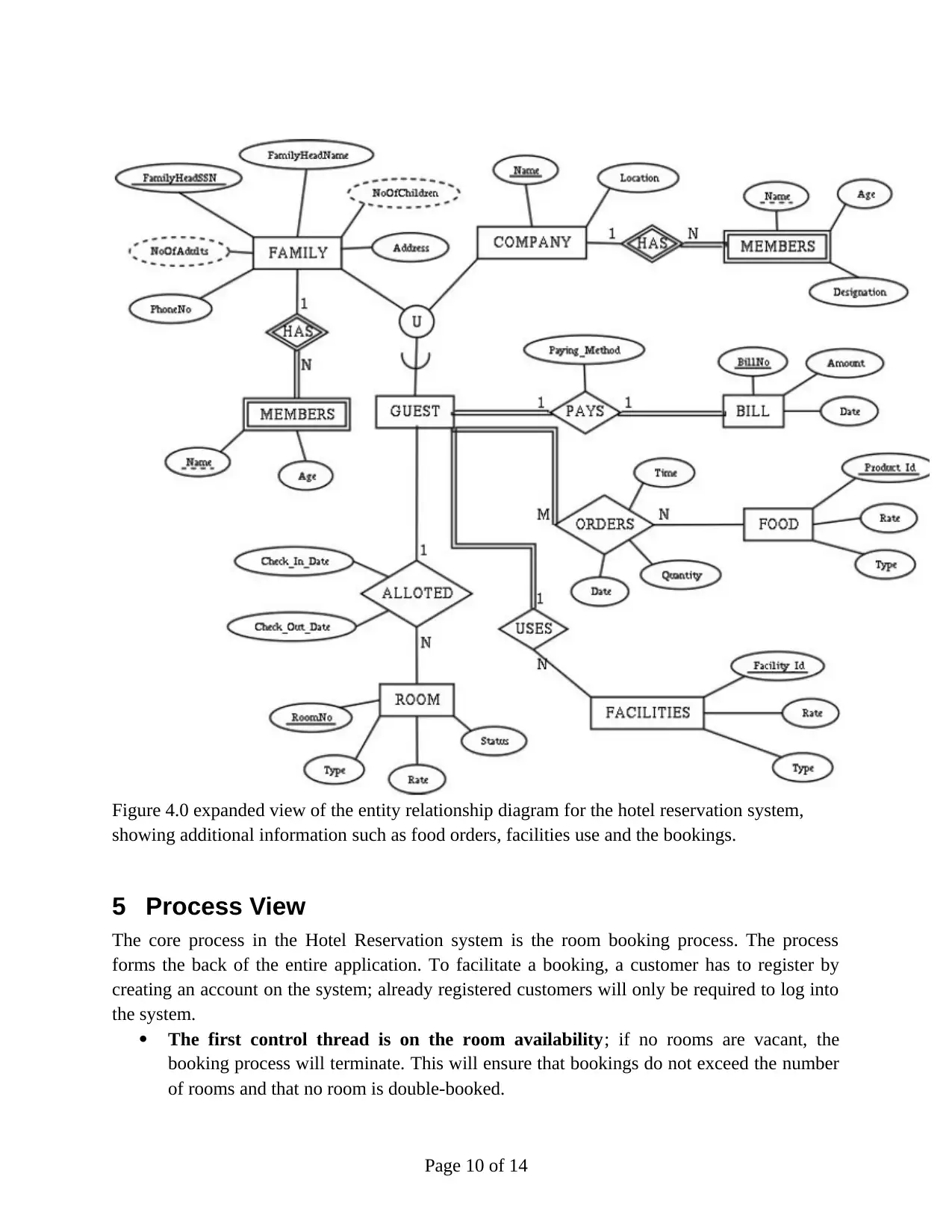
Figure 4.0 expanded view of the entity relationship diagram for the hotel reservation system,
showing additional information such as food orders, facilities use and the bookings.
5 Process View
The core process in the Hotel Reservation system is the room booking process. The process
forms the back of the entire application. To facilitate a booking, a customer has to register by
creating an account on the system; already registered customers will only be required to log into
the system.
The first control thread is on the room availability; if no rooms are vacant, the
booking process will terminate. This will ensure that bookings do not exceed the number
of rooms and that no room is double-booked.
Page 10 of 14
showing additional information such as food orders, facilities use and the bookings.
5 Process View
The core process in the Hotel Reservation system is the room booking process. The process
forms the back of the entire application. To facilitate a booking, a customer has to register by
creating an account on the system; already registered customers will only be required to log into
the system.
The first control thread is on the room availability; if no rooms are vacant, the
booking process will terminate. This will ensure that bookings do not exceed the number
of rooms and that no room is double-booked.
Page 10 of 14
Paraphrase This Document
Need a fresh take? Get an instant paraphrase of this document with our AI Paraphraser
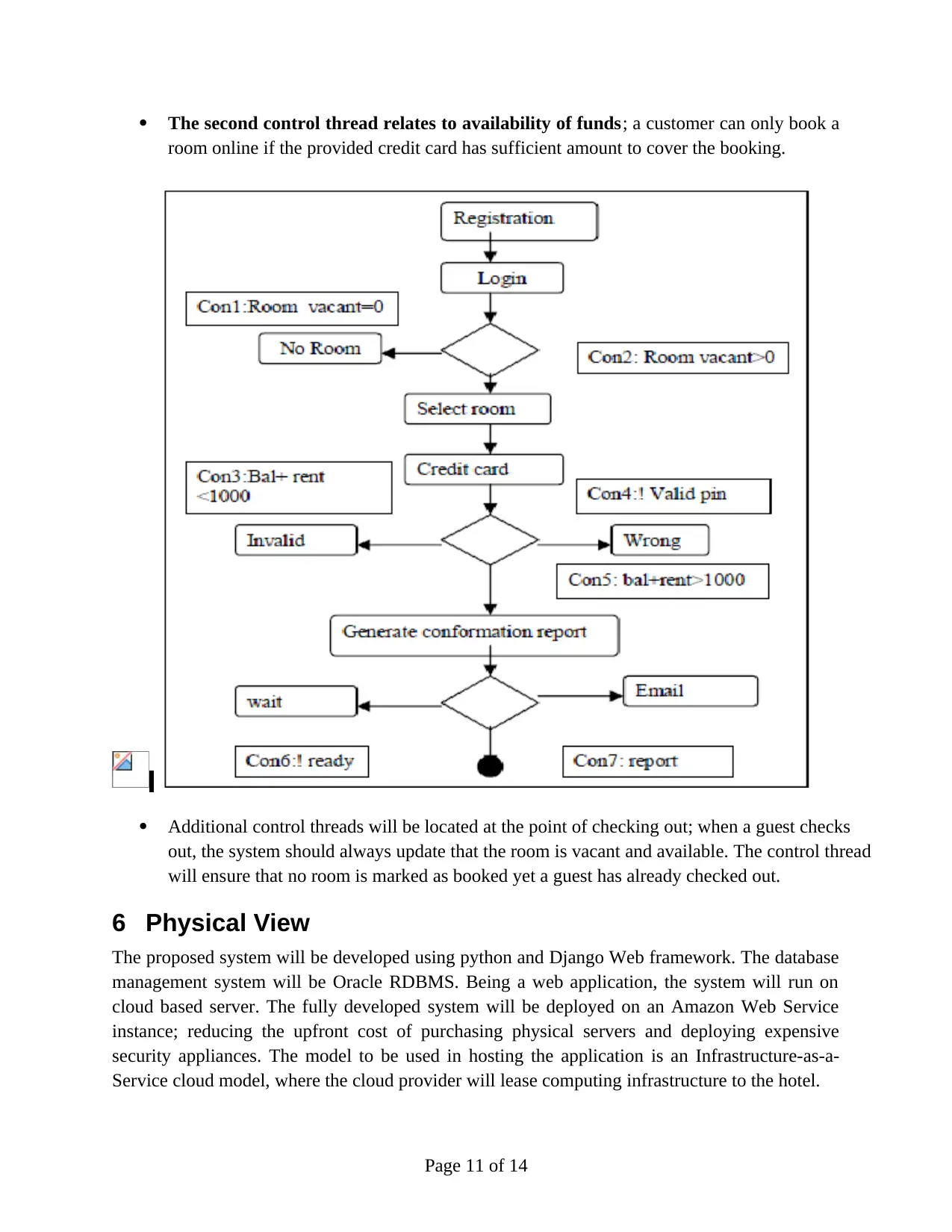
The second control thread relates to availability of funds; a customer can only book a
room online if the provided credit card has sufficient amount to cover the booking.
Additional control threads will be located at the point of checking out; when a guest checks
out, the system should always update that the room is vacant and available. The control thread
will ensure that no room is marked as booked yet a guest has already checked out.
6 Physical View
The proposed system will be developed using python and Django Web framework. The database
management system will be Oracle RDBMS. Being a web application, the system will run on
cloud based server. The fully developed system will be deployed on an Amazon Web Service
instance; reducing the upfront cost of purchasing physical servers and deploying expensive
security appliances. The model to be used in hosting the application is an Infrastructure-as-a-
Service cloud model, where the cloud provider will lease computing infrastructure to the hotel.
Page 11 of 14
room online if the provided credit card has sufficient amount to cover the booking.
Additional control threads will be located at the point of checking out; when a guest checks
out, the system should always update that the room is vacant and available. The control thread
will ensure that no room is marked as booked yet a guest has already checked out.
6 Physical View
The proposed system will be developed using python and Django Web framework. The database
management system will be Oracle RDBMS. Being a web application, the system will run on
cloud based server. The fully developed system will be deployed on an Amazon Web Service
instance; reducing the upfront cost of purchasing physical servers and deploying expensive
security appliances. The model to be used in hosting the application is an Infrastructure-as-a-
Service cloud model, where the cloud provider will lease computing infrastructure to the hotel.
Page 11 of 14
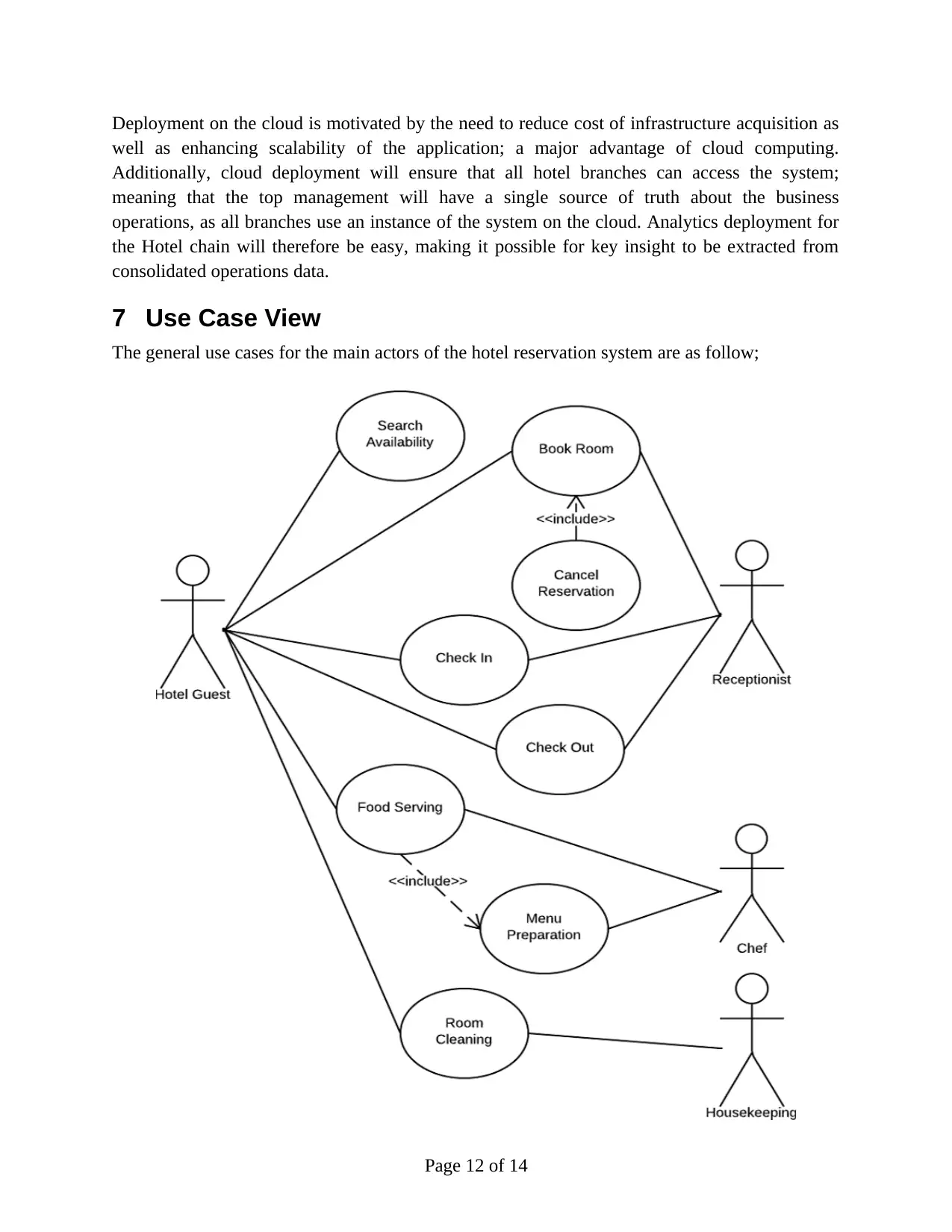
Deployment on the cloud is motivated by the need to reduce cost of infrastructure acquisition as
well as enhancing scalability of the application; a major advantage of cloud computing.
Additionally, cloud deployment will ensure that all hotel branches can access the system;
meaning that the top management will have a single source of truth about the business
operations, as all branches use an instance of the system on the cloud. Analytics deployment for
the Hotel chain will therefore be easy, making it possible for key insight to be extracted from
consolidated operations data.
7 Use Case View
The general use cases for the main actors of the hotel reservation system are as follow;
Page 12 of 14
well as enhancing scalability of the application; a major advantage of cloud computing.
Additionally, cloud deployment will ensure that all hotel branches can access the system;
meaning that the top management will have a single source of truth about the business
operations, as all branches use an instance of the system on the cloud. Analytics deployment for
the Hotel chain will therefore be easy, making it possible for key insight to be extracted from
consolidated operations data.
7 Use Case View
The general use cases for the main actors of the hotel reservation system are as follow;
Page 12 of 14
⊘ This is a preview!⊘
Do you want full access?
Subscribe today to unlock all pages.

Trusted by 1+ million students worldwide
1 out of 14
Related Documents
Your All-in-One AI-Powered Toolkit for Academic Success.
+13062052269
info@desklib.com
Available 24*7 on WhatsApp / Email
![[object Object]](/_next/static/media/star-bottom.7253800d.svg)
Unlock your academic potential
Copyright © 2020–2025 A2Z Services. All Rights Reserved. Developed and managed by ZUCOL.





